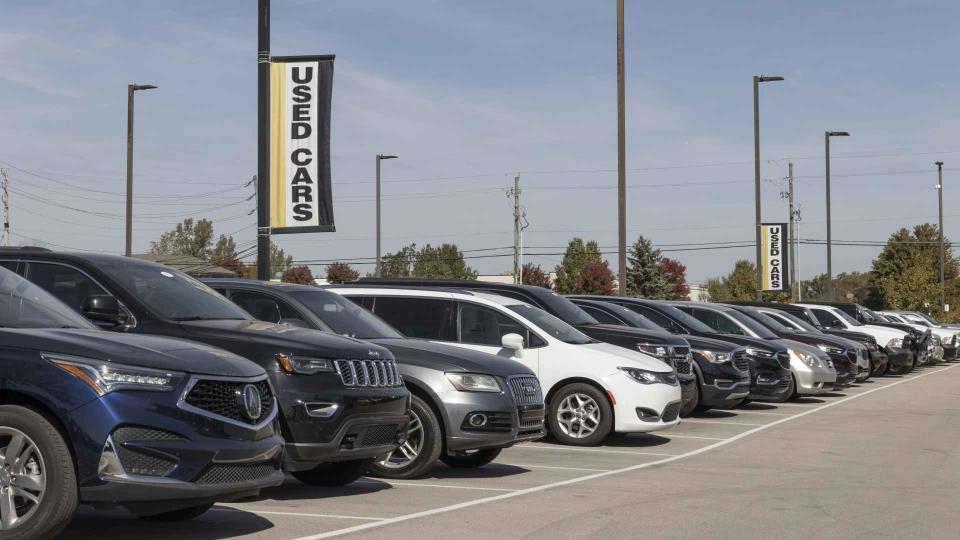Why You Might Lose Up To $6,000 on Your Car Trade-In

If you currently own a car and are thinking of trading it in to afford a newer model, you might want to do some math to make sure it is worth it. According to Bloomberg News, trade-ins for underwater vehicles are costing buyers of new cars nearly $6,000. “Among new car buyers, those carrying negative equity on their trade-ins were underwater by an average of $5,820 in September,” it reported.
Learn More: 6 Car Brands With Reliable Used Cars
Find Out: How To Get $340 Per Year in Cash Back on Gas and Other Things You Already Buy
Trading in your old car to help supplement the cost of a new one might seem like the right move, but there is a lot to consider before you even set foot in the dealership. Here’s what to consider and details on why you might lose money on your car trade-in.
Trading In Your Car Could Cost You
“Trading in a car at a dealership can sometimes result in a financial loss for the seller due to several factors,” said Geoff Cudd, founder of FindTheBestCarPrice. “When a consumer trades in a vehicle, the dealership assesses the car’s value based on its condition, market demand and resale potential. This assessment might be significantly lower than the market value, particularly if the car requires repairs or is not in demand.”
Typically, the trade-in offer will be lower than what you might receive selling the car outside of a dealership, according to Joe Giranda, director of sales and marketing at CFR Classic.
“This lower offer helps the dealership cover costs associated with refurbishing the car and adds a profit margin when reselling it,” Giranda explained. “For example, if your car is worth $10,000 in a private sale, the dealership might only offer you $7,000 to ensure they can sell it at a higher price and still make a profit.”
“Dealerships need to make a profit on the cars they sell, including trade-ins,” Cudd pointed out. “This means they often offer less than what the car might be sold for in a private sale.”
When a vehicle is “underwater” or “upside down,” it’s usually referring to the loan on the car. If you currently owe more on the car you own than the trade-in value is worth, then this term applies to you. In this case, the owner must “roll over the negative equity into the new car loan, increasing the total amount financed and potentially leading to financial strain,” Giranda said.
“Negative equity, where you owe more on the loan than the car’s worth, exacerbates this loss,” added Shawn Miller, senior writer at Modified Rides. “This undervaluation hurts buyers relying on trade-ins for new car purchases, leaving them with less capital and higher financing needs.”
For buyers who rely on the trade-in value to finance a new car purchase, it can reduce their purchasing power, Cudd noted. This is particularly true when it comes to cars bought on loans that are now underwater.
“A lower trade-in offer means less equity to apply towards the new vehicle, which can result in higher financing costs or the need to adjust purchase plans,” Cudd said.
Read Next: 10 New Cars To Avoid Buying in 2024
How To Get a Better Price
As is so often the case, if you are looking to sell your car and get a better price, it’s better to try to put it on the market yourself via sites like Craigslist. That way, you have some wiggle room to negotiate the terms of the sale and get a price that is not only a fair value but fair to you as well. Before you go this route, make sure to assess your current car’s value through a site like Kelley Blue Book.
“Dealerships absolutely low-ball their offers, but by selling your car yourself, you have more control over the final selling point,” said Ben Michael, the director of auto at Michael & Associates. “However, selling it yourself is going to require a lot more work on your behalf. You’ll have to get your car cleaned and repaired, list it for sale, field inquiries and offers, and handle test drives, all by yourself.”
The trade-in dilemma is increasingly fraught and difficult to navigate in the current retail climate. New car prices are incredibly high while inventory remains relatively low. You could find yourself stuck in a situation where you cannot afford the make and model you desire, or maybe even spending a lot more than you budgeted for in order to get the exact car you want.
“Understanding the true value of your car and exploring multiple selling options, such as private sales or selling to online platforms, might help mitigate these losses and provide more bargaining power at the dealership,” Cudd said.
More From GOBankingRates
Barbara Corcoran: 3 Cities To Invest in Real Estate Now Before Prices Skyrocket
This is The Single Most Overlooked Tool for Becoming Debt-Free
This article originally appeared on GOBankingRates.com: Why You Might Lose Up To $6,000 on Your Car Trade-In

 Yahoo Finance
Yahoo Finance 